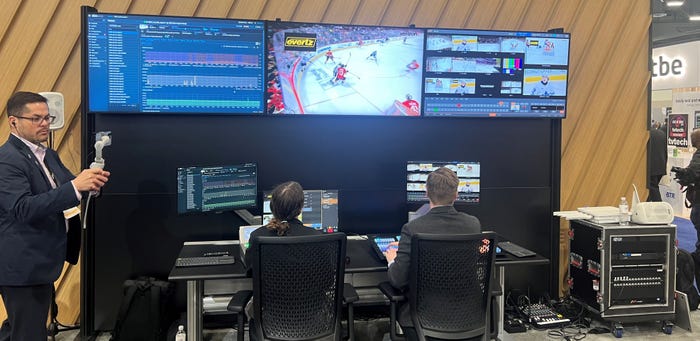Verizon taps into 5G, the edge and the cloud to cut live TV sports
At NAB, Verizon Business showed off the future of live TV production by using its public 5G network, in tandem with its edge compute capabilities and AWS's cloud, to cut and edit a live NHL game.
At a Glance
- How the combo of 5G, edge compute and the cloud can cut down latency to the sub-millisecond range (01:15)
- How the setup reduces the need for on-premises production trucks (02:22)
- How this edge and cloud architecture is driving change into the way live TV sporting events are produced (11:15)
Use cases for 5G networks, edge compute and the cloud are starting to take several new paths. At this week's NAB show in Las Vegas, Verizon Business showcased an emerging one as it tapped into all three of those components to remotely cut and edit the live TV production of Tuesday's (April 16) National Hockey League (NHL) matchup between the Florida Panthers and the Toronto Maple Leafs.

Verizon Business cut an NHL game live from the NAB show floor. (Source: Jeff Baumgartner/Light Reading)
Situated on the NAB show floor in Las Vegas, the remote staff used a live feed of the game to edit replays and other elements of the game using Verizon's 5G network, its latency-reducing edge compute platform and AWS's Wavelength Zones mobile edge compute service. Verizon Business showed how this setup can reduce the latency required to capture and cut action on the ice from seconds to milliseconds.
This mobile approach represents a big shift from the traditional way of performing these functions, which can typically require multiple production trucks to be located on-premises, Tim Stevens, global leader, strategic innovation, media and entertainment, explained here from the show floor.
"I would say it's a first," Stevens said. "We are cutting a game live on the floor of NAB. We have live camera feeds coming in from the Panthers' arena down in Florida. We are cutting the game live and then putting that program feed out, delivering it not only to the floor of NAB, but also putting it out in an HLS [HTTP Live Streaming] stream where we can actually deliver it to handsets."
Another big key is that approach can reduce initial latencies below the one second mark, rather than the 7-10 second delay typically seen with satellite distribution, plus the 20 to 30 seconds of additional latency typically seen when content is prepared for output to a mobile device, he explained.
Here's a snapshot of what was discussed (click the closed captioning button in the player for a lightly edited transcript):
Stevens provides an overview of the 5G/cloud/edge platform set up at NAB to cut the live NHL game (00:40)
How the combo of 5G, edge compute and the cloud can cut down latency to the sub-millisecond level (01:15)
How this remote setup cuts down the need for on-premises production trucks (02:22)
How this approach differs from the traditional way of cutting a live sports broadcast (04:10)
More detail about how Verizon Business is using its public 5G network and edge architecture to deliver this capability without enhancements such as network slicing (08:15)
How this edge and cloud architecture is driving change into the way live TV events are produced (11:15)
About the Author(s)
You May Also Like












